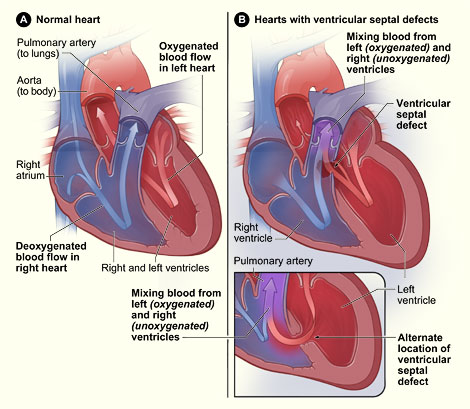Ventricular septal defect (VSD) is a hole (defect) in the wall that separates
the lower chambers of the heart. The lower
chambers of the heart are called the ventricles. The wall between them is
called the ventricular septum. In the normal heart, the septum prevents
blood from flowing directly from one ventricle to the other. In a heart
with a VSD, blood can flow directly between the two ventricles.
VSD is a congenital heart defect,
which means that it is present at birth. In children with a VSD, blood usually flows through the defect from the left ventricle to the right ventricle.
This causes extra blood (called volume overload) in the pulmonary
arteries and lungs, and in the left atrium and left ventricle.
Effects of VSD
Over time, a VSD that does not close – especially a large VSD –
can cause:
Congestive heart failure.
Infants with large VSDs may develop congestive heart failure. Extra
blood flows from the left ventricle through the right ventricle to the
lungs and back to the left atrium and on to the left ventricle. This
causes the left atrium and left ventricle to handle an increased amount
of blood, and the workload on the heart increases. The increased workload
on the heart also increases the heart
rate and the body's demand for energy. The extra blood flow in the
lungs may cause rapid breathing, while also increasing the body's demand
for energy.
Growth failure, especially in infancy. Your baby
may not be able to eat enough to keep up with his or her body's increased
energy demands. Your baby may lose weight or fail to grow and develop
as he or she should.
Bacterial endocarditis is an infection of the lining of the heart, valves, or arteries. Endocarditis
often occurs following dental and medical procedures.
Irregular heartbeat or rhythm (arrhythmia).
The extra blood flowing into the left atrium can cause the atrium to
stretch and enlarge. When this occurs, your child can develop a fast
heartbeat with symptoms such as dizziness or fainting.
Pulmonary
arterial hypertension (high
blood pressure in the pulmonary arteries). If a moderate or large
VSD is not closed, sustained blood flow under higher pressure into the
pulmonary arteries causes the arteries to become thickened and stiff.
The amount of blood flow to the lungs decreases over time as the resistance
to blood flow into the pulmonary arteries increases. However, this causes
the right ventricle to work harder. Today, pulmonary artery hypertension
rarely develops because most large or moderate VSDs are closed in infancy
or early childhood.
Characteristics
VSD is the most common type of congenital heart defect. Infants born with
a VSD may have a single hole or more than one hole in the wall that separates
the two ventricles. The defect may also occur by itself or with other congenital
heart defects.
Types
Doctors classify VSDs based on the:
Size of the defect.
Location of the defect.
Number of defects.
Presence or absence of a ventricular septal aneurysm – a thin flap of tissue on the septum. It is harmless and can
help a VSD close on its own.
VSDs range in size from small to large.
Small VSDs usually allow only a small amount of blood flow between
the ventricles. Because of this, they are sometimes called restrictive.
Most small VSDs:
- Do not cause symptoms in infants and children
- Close on their own, often by school age
- Rarely need surgery or other procedures to close the defect
Moderate (or medium-sized) VSDs are less likely than small defects
to close on their own. They may require surgery to close and may cause
symptoms during infancy and childhood.
Large VSDs allow a large amount of blood to flow from the left ventricle
to the right ventricle and are sometimes called nonrestrictive. A large
VSD is less likely to close completely on its own, but it may get smaller.
A large VSD can cause more symptoms in infants and children, and surgery
is usually needed to close it.
VSDs are found in different parts of the septum.
Membranous VSDs are located near the heart valves. They can close
at any time if a ventricular septal aneurysm is present.
Muscular VSDs are found in the lower part of the septum. They are
surrounded by muscle, and most close on their own during early childhood.
Inlet VSDs are located close to where blood enters the heart. They
are less common than membranous and muscular VSDs.
Outlet VSDs are found in the part of the ventricle where the blood
leaves the heart. This is the rarest type of VSD.
Outlook
Most VSDs close on their own or are so small that they don't need treatment.
Some children and adults need surgery or other procedures to close the VSD,
especially if it is large. Most children and adults live long and productive
lives after their VSD closes or is repaired.



